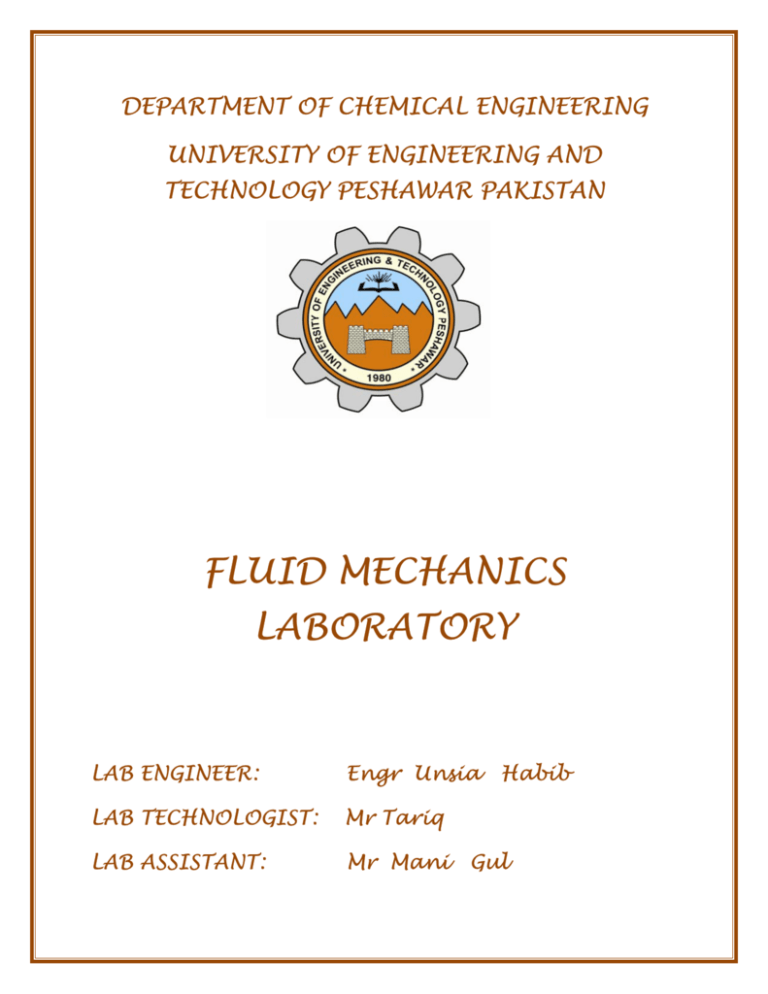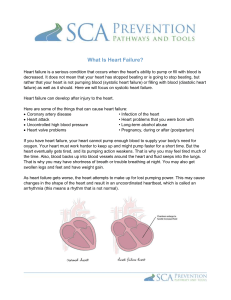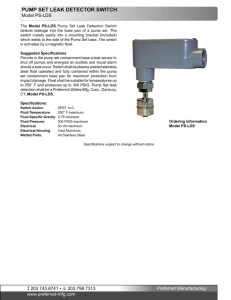fluid mechanics laboratory - University of Engineering & Technology
advertisement

DEPARTMENT OF CHEMICAL ENGINEERING UNIVERSITY OF ENGINEERING AND TECHNOLOGY PESHAWAR PAKISTAN FLUID MECHANICS LABORATORY LAB ENGINEER: Engr Unsia LAB TECHNOLOGIST: Mr Tariq LAB ASSISTANT: Mr Mani Habib Gul Fluid Mechanics Laboratory Fluid Mechanics Laboratory (CHE -232L) The Fluid Mechanics Laboratory covers practical aspects of fluid flow for both compressible and incompressible fluids and its properties. It features the following equipment: , Bernoulli's apparatus, Osborne Reynolds Demonstration unit, Multi Pump Test Rig, Fluid Friction Measurement unit, Fixed and Fluidized Bed Equipment, centrifugal fan and centrifugal pump . Equipments in Fluid Mechanics in Laboratory S. No Name of Equipment Make / Model Number Quantity 1 Osborne Reynolds Demonstration unit Armfield F1-20 1 2 Bernoulli’s theorem demonstration unit Armfield F!-15 1 3 Multi –Pump Test Rig ArmfieldC3-MKII 1 4 Fluid Friction Measurement unit Armfield C6-MKII 1 5 Centrifugal Fan demonstration unit Armfield FM-10 1 6 Centrifugal Pump demonstration unit Armfield FM-50 1 7 Fixed and Fluidized Bed Equipment Armfield CEL 1 8 Particle drag co-efficient ArmfieldF12 1 9 Pure Water Feeder Auto still Yamato WG55 1 10. Perfector – E (water purification unit) PWN Technologies 1 2 Department of Chemical Engineering U. E. T Peshawar Fluid Mechanics Laboratory EQUIPMENTS DESCRIPTION 1. Osborne Reynolds Demonstration unit The unit has been designed for students experiment on the laminar, transition and turbulent flow. It consists of a transparent header tank and a flow visualization pipe. The header tank is provided with a diffuser and stilling materials at the bottom to provide a constant head of water to be discharged through a bell mouth entry to the flow visualization pipe. Flow through this pipe is regulated using a control valve at the discharge end. The water flow rate through the pipe can be measured using the volumetric tank (or measuring cylinder) of a Hydraulics Bench. Velocity of the water can therefore be determined to allow for the calculation of Reynolds’ number. A dye injection system is installed on top of the header tank so that flow pattern in the pipe can be visualized Figure 1: Osborne Reynolds Demonstration unit 3 Department of Chemical Engineering U. E. T Peshawar Fluid Mechanics Laboratory 2. Bernoulli’s theorem demonstration unit The Bernoulli’s Theorem states that the sum of pressure head, velocity head and the potential head is constant along a stream line for a steady, in viscid and incompressible flow of fluid. Bernoulli’s Theorem Demonstration Apparatus is a bench top unit and it illustrates the circumstances to which Bernoulli’s theorem can be applied. The apparatus consists of a transparent venturi tube. Wall pressure tapings are provided along the converging and diverging portions of the venturi to measure the static pressure distribution. Pitot tubes are provided to along the center line of the venturi. Static pressures are measured using multi-tube manometer having a manifold with an air bleed valve. The characteristics of the flow in both convergent and divergent portions of the venturi can be studied. This apparatus can also be used to conduct laboratory experiments to (a) demonstrate the continuity equation and (b) determine the coefficient of discharge of venturi as a flow measurement device. Figure 2: Bernoulli’s theorem demonstration unit 4 Department of Chemical Engineering U. E. T Peshawar Fluid Mechanics Laboratory 3. Multi –Pump Test Rig Multi –Pump Test Rig is speciallydesigned forstudent’s demonstrations on the principle operating characteristics of different types of pumps. The unit is supplied with centrifugal pump, turbine pump, flow pump and gear pump. The unit incorporates appropriate pipe works and tanks to make the operation self-contained. The manually operated valves and pipe work are arranged for rapid and safe selection of any one test pump. Measurement sensors are included to measure the pump speed, power, pump head and flow rate. Figure 3: Multi –Pump Test Rig 5 Department of Chemical Engineering U. E. T Peshawar Fluid Mechanics Laboratory 4. Fluid Friction Measurement unit The unit has been designed for students to study on the fluid friction head losses of an incompressible fluid flow of an incompressible .The unit is self-contained supplied with facilities for students to study the friction losses on smooth-bore pipes of various diameters and an artificially roughened pipe. In addition to the study of losses in straight pipes, a wide range of accessories are also provided including 90˚ bend elbow and 45˚ elbow and sudden contraction and enlargement, inline strainer, various valves(globe and gate valve ) and flow meters(venture meter and orifice meter). Figure 4: Fluid Friction Measurement unit 6 Department of Chemical Engineering U. E. T Peshawar Fluid Mechanics Laboratory 5. Centrifugal Fan demonstration unit (computer linked) Centrifugal fan Demonstration Unit consists of a self-contained bench top unit with a small scale centrifugal fan and all the necessary instrumentations. Transparent ducting at both inlet and outlet flows allows operation of the centrifugal fan’s impeller to be clearly observed. An orifice plate is installed in the ducting to enable measurements of air flow rates, which can be varied by means of an aperture control device. The unit can be connected to a PC for convenient data logging and recording of experimental data. The unit provides a complete study about centrifugal fan by measuring machine performance in terms of Static and total pressure, Rotor speed and motor input power as a function of inlet flow Figure 5: Centrifugal Fan demonstration unit 7 Department of Chemical Engineering U. E. T Peshawar Fluid Mechanics Laboratory 6. Centrifugal Pump demonstration unit (computer linked) This Centrifugal Pump Demonstration Unit enables students to perform the characteristic studies of a centrifugal pump. The centrifugal pump is designed with transparent casing to allow visualisation of the impeller rotation. The unit is used to measure the inherent pump performance including production ofCharacteristics curves of flow rate against pump total head, motor input,impeller speed, Overall total efficiency and the Introduction of pump speed laws Figure 6: Centrifugal Pump demonstration unit 8 Department of Chemical Engineering U. E. T Peshawar Fluid Mechanics Laboratory 7. Fixed and Fluidized Bed Equipment The apparatus is designed to facilitate the study of flow through fixed and fluidized beds of solid particles. There is Provision for the simultaneous study of air and water systems in the unit to demonstrate the difference between 'aggregative' and 'particulate' fluidized bed characteristics. Students can readily observe the important phenomenon of 'bubbling’. Upward flow of fluid through a bed of particles is a naturally occurring phenomenon, for example the movement of ground water. Industrial applications include ion-exchange, extraction of soluble components from raw materials and other chemical processes Figure 7: Fixed and Fluidized Bed Equipment 9 Department of Chemical Engineering U. E. T Peshawar Fluid Mechanics Laboratory 8. Particle drag co-efficient The apparatus has been designed to introduce the fundamental characteristics of the behaviour of particle/fluid systems, in particular the relationship between the drag coefficients of falling particles and their Reynolds number value. Particles covering a range of sizes and densities are supplied. Figure 8: Particle drag co‐efficient 10 Department of Chemical Engineering U. E. T Peshawar Fluid Mechanics Laboratory List of Experiments S.No Name of Experiments 1. To investigate the type of flow 2. To prove the Bernoulli’s equation experimentally 3. To calculate the energy loss due to sudden expansion and contraction in fluid friction apparatus 4. To calculate the volumetric flow rate through venturi meter 5. To calculate the flow rate through Pitot tube. 6. To find the volumetric flow rate through orifice meter 7. To calculate the energy loss due to fittings and valves 8. To investigate the effect of pipe diameter on pressure drop. 9. To find the relation between head loss and flow rate 10. To investigate the relationship between pressure head , flow rate , power consumed and efficiency of a pump 11 Department of Chemical Engineering U. E. T Peshawar






